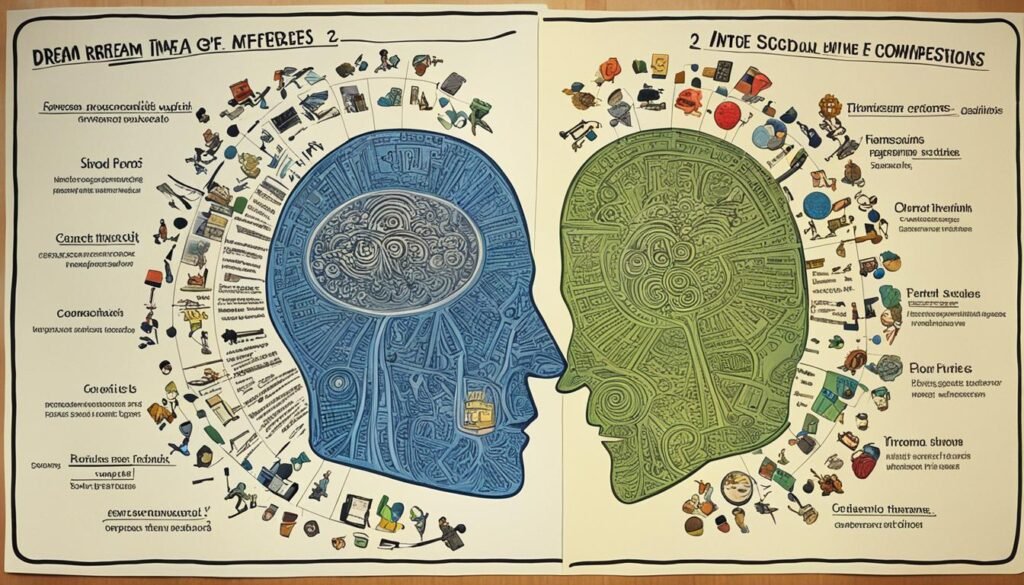Welcome to our in-depth exploration of dream theories! Dreams have fascinated humanity for centuries, and countless theories have been proposed to unravel their mysteries. In this article, we will delve into the Comparative Analysis of Dream Theories, offering valuable insights into the different perspectives on dreaming. By examining the theories of Sigmund Freud, Carl Jung, and modern scientific research, you will gain a deeper understanding of the complex and fascinating nature of dreams.
Key Takeaways:
- Comparative analysis of dream theories offers valuable insights into the different perspectives on dreaming.
- By examining the theories of Freud, Jung, and modern science, you can gain a deeper understanding of the complex and fascinating nature of dreams.
- Dream research plays a crucial role in exploring the unconscious mind and understanding the factors that contribute to mental disturbances.
- Various techniques have been developed for interpreting dreams, each offering unique approaches to unraveling their meanings.
- In therapy, dreams can serve as a valuable tool for understanding transference, countertransference, and other aspects of the therapeutic relationship.
Freud’s Dream Theories
Freud’s dream theory is one of the most well-known and influential psychological theories of dreams. According to Freud, dreams serve as a window into the unconscious mind, allowing hidden desires and symbolism to manifest themselves. Understanding the complex interplay between the manifest and latent content of dreams is key to unlocking their meaning.
In Freud’s theory, dreams have two distinct components: manifest content and latent content. Manifest content refers to the actual elements and events experienced in a dream, such as people, objects, and actions. On the other hand, latent content represents the hidden unconscious desires, repressed memories, and symbolic meanings behind the manifest content.
Freud proposed that dreams are the fulfillment of a person’s unconscious wishes, often stemming from childhood experiences or repressed desires. He believed that the dream work process involves condensation, in which multiple thoughts and emotions are compressed into a single symbol or image, displacement, where the emotional significance of a thought or object is transferred to something else, and symbolism, in which unconscious desires are represented through symbolic imagery.
Analyzing both the manifest and latent content of dreams is crucial in Freud’s dream theory. By examining the actual events and symbols present in a dream, one can unravel the deeper meanings and unconscious desires that lie beneath the surface. This analysis provides valuable insights into an individual’s psyche, helping to uncover repressed traumas, unresolved conflicts, and hidden desires.
Freud’s dream theory has had a profound impact on the field of psychology and continues to shape our understanding of dreams and the unconscious mind. While his ideas have been subject to criticism and controversy, his emphasis on the importance of analyzing both the manifest and latent content of dreams has remained a central tenet in the study of dream interpretation.
Jung’s Dream Theory
In the realm of dream interpretation, Jung’s dream theory offers a unique perspective on the unconscious mind and the symbolic messages embedded within our dreams (Second source). According to Jung, dreams serve as a bridge to explore the hidden realms of our psyche, providing a window into the unconscious mind and unlocking important insights about our inner world.
Jung introduced the concept of archetypes, which are universal patterns or symbols that represent collective human experiences and emotions (Second source). These archetypes act as the building blocks of dreams, manifesting as recurring symbols with deep cultural or psychological significance. By decoding these archetypal symbols in our dreams, we can gain a profound understanding of our own personal journey and tap into the wisdom of our shared human experiences.
Dream interpretation in Jung’s theory involves delving into the symbols and archetypes present in the dream and unraveling their hidden meanings (Second source). By deciphering these symbolic messages, we gain valuable insights into the depths of our personality, emotions, and unconscious desires. It is through this process of symbolic dream interpretation that we can unlock the transformative power of our dreams and harness their potential for personal growth and self-discovery.


In Summary
- The cognitive theory of dreams emphasizes the role of dreams in memory consolidation during sleep (First source).
- Dream content can reflect recent events in a person’s life, including both newly encoded memories and long-term memories, a phenomenon known as the dream-lag effect (First source).
- Researchers continue to explore the intricate relationship between dreaming and memory processes to gain a deeper understanding of cognitive function during sleep.
Neuroscientific Theories of Dreams
Neuroscientific theories of dreams delve into the intricate physiological processes that occur in the brain during dreaming. Rapid eye movement (REM) sleep, known for its association with vivid dreaming, plays a crucial role in emotional memory processing. It is believed that during REM sleep, the brain consolidates and processes emotional memories, aiding in their integration and understanding.
On the other hand, non-REM (NREM) sleep is closely linked to the consolidation of declarative memories. Declarative memories refer to memories that can be consciously recollected, such as facts, events, and experiences. This stage of sleep is essential for the solidification of new information and the integration of knowledge acquired during wakefulness.


Dream Interpretation Techniques
When it comes to interpreting dreams, a variety of techniques have been developed to help uncover their meaning and significance. One popular approach is the self-evident method, which places emphasis on the direct reflection of dreams on the dreamer’s experiences and wishes. According to researchers, manifest dream content—the actual elements and events experienced in a dream—represents the true essence of the dream and should be analyzed without relying on hidden or symbolic meanings.
By focusing on the manifest content, dream interpretation becomes a self-evident process that allows individuals to gain insights into their own thoughts, emotions, and experiences. This method is particularly helpful for those who prefer a more straightforward and tangible approach to understanding their dreams.
While some techniques delve into symbolism and hidden meanings, the self-evident method offers a practical and accessible way for individuals to interpret their dreams. By exploring the manifest content and its connection to personal experiences and desires, dreamers can gain valuable insights into their own subconscious thoughts and emotions.
Manifesting the True Essence of Dreams
Using the self-evident method, individuals can explore the manifest dream content without getting entangled in complex interpretations. By analyzing the actual elements and events experienced in a dream, dreamers can unlock the hidden messages and insights contained within. This approach allows for a more direct and self-revealing understanding of dream content.
By focusing on the manifest content and its connection to one’s own experiences, the self-evident method provides a clear and tangible path to understanding the true essence of dreams. This technique can be especially beneficial for those who prefer a practical and straightforward approach to dream interpretation.
To illustrate the power of the self-evident method, consider the following example:
- You dream of standing on a stage and delivering a powerful speech.
- Using the self-evident method, you analyze the manifest content—being on stage and giving a speech—to uncover its meaning.
- Your personal experiences and desires reveal that the dream may symbolize a desire for recognition, self-expression, or a fear of public speaking.
- Through this analysis, you gain a deeper understanding of your own thoughts, emotions, and aspirations.


Unlocking the Secrets Within
The self-evident method offers a valuable and accessible approach to dream interpretation. By focusing on the manifest content and its direct reflection of personal experiences and desires, dreamers can uncover hidden insights and gain a deeper understanding of their own subconscious mind.
While dreams may sometimes contain symbolic or hidden meanings, the self-evident method provides a self-explanatory and intuitive way to interpret dreams. By embracing the manifest content and its connection to the dreamer’s own reality, individuals can unlock the secrets and messages encoded within their dreams.
Discover the power of the self-evident method and embark on a journey of self-discovery through dream interpretation.
The Role of Dreams in Therapy
In therapy, dreams play a significant role in understanding the dynamics of the therapeutic relationship. Through the analysis of dream content, therapists gain valuable insights into patients’ emotions, past experiences, and unconscious conflicts (First source).
Dreams in therapy provide a unique window into the inner workings of the mind, allowing both the therapist and the client to explore the depths of their psyches. Transference dreams, in particular, offer a reflection of the client’s projections and emotions onto the therapist, highlighting the dynamics of the therapeutic relationship (First source).
Furthermore, countertransference dreams experienced by the therapist shed light on their own feelings, attitudes, and unresolved issues that may influence the therapeutic process (First source). By addressing and understanding these countertransference reactions, therapists can enhance their self-awareness and ensure they maintain a balanced and effective therapeutic alliance (First source).
The exploration of dreams in therapy provides a powerful platform for uncovering unconscious material, facilitating self-discovery, and promoting healing. By delving into the rich symbolism and narrative of dreams, therapists can guide their clients towards greater self-understanding, self-acceptance, and personal growth (First source).
The Therapeutic Benefits of Dream Analysis
- Insight into Unconscious Conflicts: Dream analysis offers a pathway to gain insight into the unconscious conflicts and desires that may be influencing a client’s thoughts, emotions, and behaviors.
- Emotional Processing: Dreams provide a safe space for clients to process and express their emotions, especially those that may be difficult to access or articulate in waking life.
- Exploration of Symbols and Archetypes: Dream symbols and archetypes offer a rich palette for exploring personal and collective unconscious themes, promoting deeper self-awareness and meaning-making.
- Integration of Experiences: Dreams can help integrate and make sense of past experiences, traumas, and unresolved issues, facilitating the healing process.
- Strengthening the Therapeutic Relationship: The exploration of dreams fosters a deeper level of trust, collaboration, and understanding between the therapist and client, enhancing the therapeutic alliance.


By incorporating dream analysis into therapy, mental health professionals can harness the power of dreams to promote personal growth, self-reflection, and emotional well-being. Dreams serve as a gateway to the unconscious, offering valuable insights and opportunities for transformation on the therapeutic journey.
The Significance of Dream Research
Dream research plays a crucial role in exploring the unconscious mind and understanding the factors that contribute to mental disturbances. By delving into the realm of dreams, researchers gain valuable insights into the inner workings of our minds and the complexities of human psychology.
Through the study of dreams, we can uncover hidden desires, unresolved conflicts, and unconscious motivations. Dreams have the ability to shed light on our deepest fears, aspirations, and emotions, providing a window into the darkest corners of our psyche.
Exploring the unconscious through dream analysis allows us to better understand the root causes of mental disturbances such as anxiety, depression, and trauma. Dreams can serve as a reflection of our inner struggles, offering clues about the underlying psychological issues that may be affecting our mental well-being.
Moreover, dreams provide a unique opportunity for self-reflection and personal growth. By unraveling the symbolism and meaning behind our dreams, we can gain valuable insights into our own identities, values, and aspirations. Dreams often bring to the surface emotions and thoughts that we may not be consciously aware of, enabling us to confront and address unresolved issues.
In a clinical setting, dreams are an important tool for diagnosis, research, and treatment. They offer clinicians a deeper understanding of a patient’s experiences, needs, and prognosis. Dream analysis can be particularly useful in therapy, as it allows therapists to unearth unconscious conflicts and guide patients towards healing and self-discovery.
Conclusion
Analyzing dream theories provides valuable insights into the complex and fascinating nature of dreams. By examining the perspectives of Sigmund Freud, Carl Jung, and modern scientific research, we can gain a deeper understanding of the workings of the human mind when it comes to dreaming.
Freud’s theory emphasizes the importance of analyzing both the manifest and latent content of dreams to uncover hidden desires and symbolism. Jung’s theory introduces the concept of archetypes, which contribute to the symbolic messages present in dreams.
Furthermore, cognitive and neuroscientific theories shed light on the cognitive processes and brain activity associated with dreaming. The comparative analysis of these theories highlights the significance of considering multiple perspectives in order to fully explore and interpret the rich tapestry of dreams.
Insights gained from analyzing dream theories can have broader implications in various fields, such as therapy and research. Dreams serve as a valuable tool in therapy, providing therapists with a window into patients’ emotions, past experiences, and unconscious conflicts. Dream research also plays a crucial role in understanding mental disturbances and contributes to diagnosis, research, and treatment in clinical settings.
Overall, the comparative analysis of dream theories underscores the importance of taking a comprehensive and multidisciplinary approach to studying and interpreting dreams. By considering different perspectives and incorporating insights from various theories, we can unlock the mysteries of dreams and gain a deeper understanding of the human mind’s intricate workings.
How Do Dream Symbols in Art Compare to Theories on Dream Interpretation?
When exploring dream symbols in art, it’s fascinating to compare them to theories on dream interpretation. Artists often depict common dream symbols, such as flying or falling, which can align with psychological interpretations of the subconscious mind. This intersection offers a unique perspective on the universal language of dreams.

